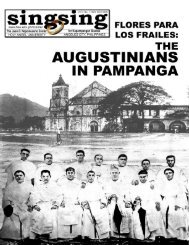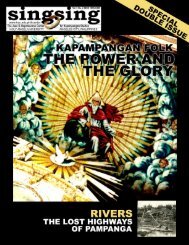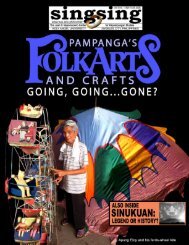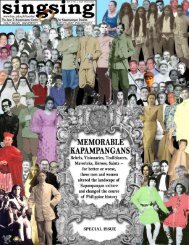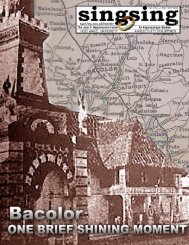Download PDF - Holy Angel University
Download PDF - Holy Angel University
Download PDF - Holy Angel University
You also want an ePaper? Increase the reach of your titles
YUMPU automatically turns print PDFs into web optimized ePapers that Google loves.
20<br />
A A 1911 1911 A CCOUNT CCOUNT OF OF THE THE EARL EARLY EARL EARLY<br />
Y YEARS<br />
YEARS<br />
NAMED AMED AFTER<br />
AFTER<br />
TW TWO TW O ANGELS<br />
ANGELS<br />
THE NEW TOWN WAS NAMED AFTER<br />
THE LOS ANGELES CUSTODIOS BUT ACTUALLY IN<br />
HONOR OF DON ANGEL PANTALEON DE MIRANDA<br />
By Lupo Ramos<br />
From the Luther Parker Collections<br />
<strong>University</strong> of the Philippines (Diliman) Main Library<br />
Signature of Don <strong>Angel</strong> Pantaleon de Miranda, former gobernadorcillo of San Fernando who became the founder and first<br />
gobernadorcillo of <strong>Angel</strong>es (Philippine National Archives)<br />
In 1796, Don <strong>Angel</strong> Pantaleon de<br />
Miranda and his wife, Doña Rosalia de<br />
Jesus, both from illustrious families of San<br />
Fernando, a town of Pampanga, initiated<br />
an agreement with some partners and<br />
farmers to cultivate an expanse of wild and<br />
uncultivated land called Culiat in the same<br />
town of San Fernando. A sculpted wooden<br />
statuette of the Virgin of the Rosary, to<br />
which they prayed for protection against<br />
the ambushes of the Aetas who were<br />
settled in the surroundings, was carried<br />
along in processions; they recited the Rosary<br />
every time they went down the clearing<br />
to prepare the land for planting.<br />
Some years later (1810), the couple<br />
prospered and funded the construction of<br />
“Ing Pangatatag ning Balayan <strong>Angel</strong>es,” an<br />
account of the town’s founding, written<br />
in verse form by Nicolas Vicente Navarro,<br />
a contemporary of the founder, in 1840.<br />
This is the cover of a 1923 reprint.<br />
(Courtesy of Edgardo Sibug)<br />
a Santuario made of wood and nipa, and<br />
provided the necessary furnishings for the<br />
celebration of the <strong>Holy</strong> Mass. Consequently,<br />
Culiat obtained from church authorities the<br />
appointment of a chaplain to recompense<br />
the couple for being conscientious of the<br />
spiritual needs of the community. The services<br />
were extended to the neighboring localities<br />
around Culiat, which were still under<br />
San Fernando. There were times when<br />
religious services were already administered<br />
by their own chaplain, being an autonomous<br />
cleric but sometimes still dependent<br />
on San Fernando.<br />
Considering the significant population<br />
increase of those places, the said husbandand-wife,<br />
referred now as the Founders,<br />
obtained the favor from both civil and<br />
ecclesiastic authorities to establish a town<br />
detached from San Fernando. After eight<br />
years of relentless effort, and remaining<br />
firm against opposition from successive<br />
priests of San Fernando, the authorities finally<br />
granted on December 8, 1829 the official<br />
recognition of the new town. The



